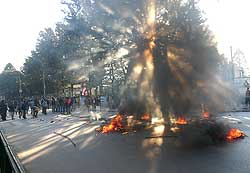 The smell of burning tyres on the streets of the capital reeks of democracy in decay. Despite prevailing winds, though, the olfactory message doesn't seem to have wafted yet into nostrils in Narayanhiti.
The smell of burning tyres on the streets of the capital reeks of democracy in decay. Despite prevailing winds, though, the olfactory message doesn't seem to have wafted yet into nostrils in Narayanhiti. The silence has goaded students into ever-increasing radical rhetoric. A section of the students have begun to lose self-control, smashing private vehicles and taxis. Fears of anarchy returning to the streets are real again. Hell hath no fury as students scorned. This raw rage comes out of alienation. Marx saw it as 'alienation from one's species' so the youngsters have been pushed to desperation by circumstances that they are 'so familiar with but of which they are hardly a part'. When the monopoly over the state power is completely in the hands of a small elite, others have no stake in upholding the status quo.
They respond by becoming uncontrollable, aggressive and violent. This kind of violence is much more dangerous than the violence of armed insurgents or the mafia, which emerge from the outside and which can be countered with a peace offensive or counter-violence. But when a social force goes berserk there is no way but to wait for it to spend itself in a cataclysmic upheaval, like what happened in Iran just before the fall
of the Shah.
Street violence is also a response to marginalisation when the power elite pushes all others to the margins. The sense of injustice is even more acute when the system is seen to be illegitimate and brutal. When ex-Mandales in government are deciding on the response to the street protests, you know we have come a full circle to 1990. Hence the statement from the government spokesman that the insurgents have infiltrated the agitating students. Last week, Buddhiman Tamang wen t to Nepalgunj on an exploratory duty for the public felicitation ceremony of the king in the mid-west region. A reporter counted
22 army SUVs had come to receive the minister, a visiting American journalist thought the bandobast was more elaborate than what the American president is used to. When students start pelting stones, blame a society which has taught them that violence is the only bargaining weapon left to them for negotiation and legitimisation.
Many students are now convinced that mild violence is a necessary evil, and the only way to make an obstinate state take notice. There is a method in the apparent madness of student protests everywhere. They can't afford to alienate the people by mindless vandalism and violence so they try to keep disorder to a minimum, aim at politically significant targets and spare likely supporters from inconvenience. For the political parties masterminding the current agitation, the risks of students' protests getting out of hand are enormous. From the experience of students' agitation in Indonesia and the Philippines, they know that if imagined grievances are allowed to fester for too long, youth protests can spiral out of control and degenerate into anarchy and end up even justifying strongman rule.
It is not such a big leap from burning tyres on the asphalt to turning them into garlands of death. The army and the government may have been crying wolf when they said Maoists have infiltrated the student protestors. Yet, if society atrophies further, that may become a reality, and we know who would be responsible.



